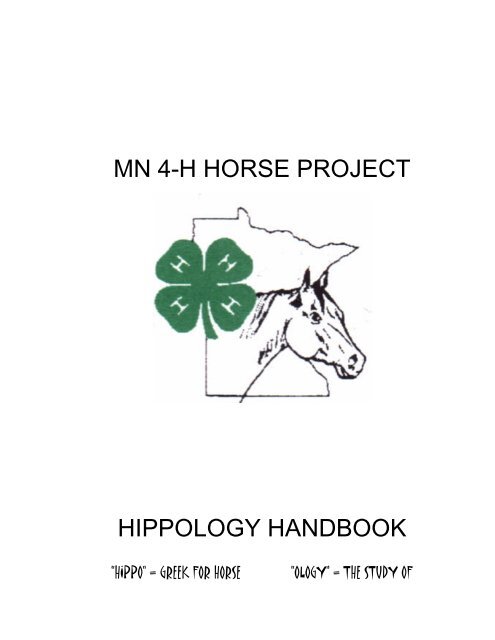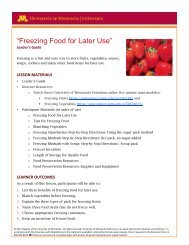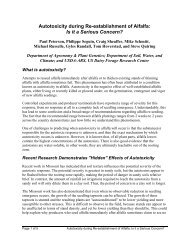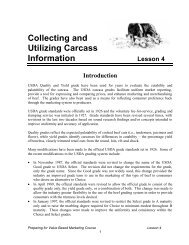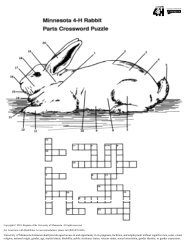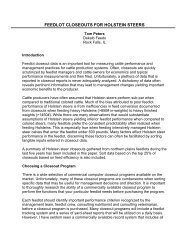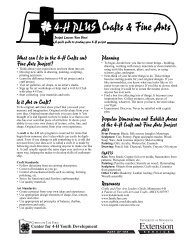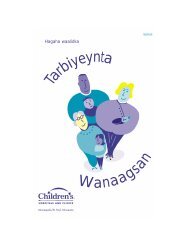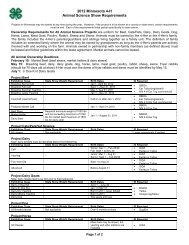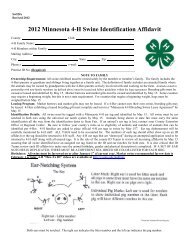MN 4-H HORSE PROJECT - University of Minnesota Extension ...
MN 4-H HORSE PROJECT - University of Minnesota Extension ...
MN 4-H HORSE PROJECT - University of Minnesota Extension ...
You also want an ePaper? Increase the reach of your titles
YUMPU automatically turns print PDFs into web optimized ePapers that Google loves.
<strong>MN</strong> 4-H <strong>HORSE</strong> <strong>PROJECT</strong>HIPPOLOGY HANDBOOK“HIPPO” = GREEK FOR <strong>HORSE</strong>“OLOGY” = THE STUDY OF
<strong>MN</strong> 4-H HIPPOLOGY HANDBOOKHippology is an activity that can make learning fun for 4-H members, by letting them exhibit their knowledge andunderstanding <strong>of</strong> equine science and husbandry in a friendly but competitive setting.ObjectivesThis educational activity would provide 4-H horse project members an opportunity to further their horse projectknowledge. This activity would provide the 4-H horse project members the opportunity to utilize knowledge and skillsdeveloped from other project activities such as knowledge bowl, horse judging, speaking and demonstrations, and generalhorse program. The objectives <strong>of</strong> the 4-H Hippology Event would be as follows:∗∗∗∗∗∗∗Provide additional educational opportunities for horse project membersDevelop skills such as decision-making, communication skills, team-building, self-confidence, and leadership skillsEnhance individual growth and developmentProvide an opportunity to inter-relate horse project knowledgeProvide an opportunity for horse project members to use their horse project knowledgeTo advance knowledge, abilities, skills and attitudesTo measure and recognize horse project achievementFUNDING<strong>MN</strong> 4-H Horse Association provides $50 per individual participating, while representing <strong>MN</strong> at an Association approvedContest. Funding paid to the team.Event ActivitiesThe Hippology Contest has four (4) different phases1) Examination Phase2) Station Phase3) Judging Phase4) Team ProblemRULES AND REGULATIONSMINNESOTA ELIGIBILITY (National requirements are different)1. Sr. team members may be no more that one-year past high school graduation. All Intermediate team members musthave comp leted sixth grade, but not their 14th birthday on Jan. 1 <strong>of</strong> the current year.2. Senior teams may be comprised <strong>of</strong> both Intermediates and seniors for the <strong>Minnesota</strong> Contest. If one member is a Sr.,the whole team is a Sr. Team.3. To be eligible to judge as substitutions for team members, list alternates on the entry form. i.e., they may be listed asalternates and also judge as an individual. Each county may pre-register three Hippology teams or participate as part <strong>of</strong> amulti-county team. (i.e., Int/Int, Int/Sr., or Sr/Sr) Each team may have three or four members. If four judge, the threehighest scores will be used. A county can have a maximum <strong>of</strong> two members participate as individuals. Counties not ableto organize their own County team are eligible for a multi-county team.4. Team members must be enrolled in 4-H, but need not be enrolled in the Horse Project to participate on a JudgingTeam, Hippology Team or Speech & Demonstration Contest. Teams may be selected by any means appropriate to theCounty they represent and must be certified as eligible by the county <strong>Extension</strong> Educator.Page 2 Revised December, 1999
<strong>MN</strong> 4-H HIPPOLOGY HANDBOOKNATIONAL CONTESTS:1. State entry form must be complete to be eligible for National Competition.2. Senior Team: 3 or 4 members who have passed their 14th, but not their 19th birthday on January 1 <strong>of</strong> thecurrent year.*** Note: <strong>MN</strong> rules are different. If your team is considering a Nat’l contest, be sure that all members over theNat’l age requirement as an Individual in the state Contest.3. Intermediate Team -3 or 4 members who have completed sixth grade, but not their 14th birthday on January 1 <strong>of</strong> thecurrent year.4. No member may be undergoing training for or have participated in <strong>of</strong>ficial post secondary horse judging events.NATIONAL CONTEST CITIRIA: ** indicate 1999 ChangesWESTERN NATIONAL 4-H CLASSIC, Denver, CO: (First eligible team MUST take)Individuals may participate in only one contest per year.An individual may not compete in the same specific contest again.An individual must not have participated in any post secondary (university, college, junior college or technicalschool) Hippology, horse bowl or horse judging competitive contest. Neither can an individual be amember <strong>of</strong> a post secondary team undergoing training in preparation for such an event.QUARTER <strong>HORSE</strong> CONGRESS, Columbus, OH: (2 trips)Individuals may participate in more than one contest per year. Individuals are allowed to compete inHippology and either Speaking/Demo or Horse Bowl. Speaking/Demo and Horse Bowl individuals couldalso compete in Hippology or Judging. (Contestants must win a <strong>MN</strong> State trip in order to do this)** Individual is ineligible if they were a high individual overall or on the high overall team.An individual may not have participated in an <strong>of</strong>ficial, post secondary Hippology, Horse Bowl or HorseJudging contest nor have been in training preparation for one <strong>of</strong> these contests.ARABIAN <strong>HORSE</strong> YOUTH NATIONALS CONTEST, Oklahoma City, OK:** All past high overall individuals are ineligible to compete again.An individual must not have participated in a collegiate judging contest.Page 3 Revised December, 1999
<strong>MN</strong> 4-H HIPPOLOGY HANDBOOKRu1es1. <strong>Minnesota</strong> Team contests (Hippology/judging/bowl) are not considered State Fair or State Horse Show trips and do notaffect eligibility for State Fair or State Horse Show individual trips. A member may participate in State Horse Showand any team contest and participate at State Fair in a team event or contest.2. Horse Show Entry Form #5, including fees, must be sent to State Show Secretary by entry deadline. No late entrieswill be accepted. Entry form must be complete to be eligible for National Competition3. Reference Material: All the information covered in this contest may be found in one or more <strong>of</strong> the following publications:CONTEST∗ Horses and Horsemanship - National 4-H Council∗ Horse Science - National 4-H Council∗ Horses and Horsemanship (6th Edition) - Ensminger∗ The Horse (2nd Edition) - Evans, Boron, Hints and Van Fleck∗ Horses - Evans∗ Catalogs distributed by Libertyville Saddle Shop, 306 Peterson Road, PO Box M, Libertyville IL, 60043and Eiders, Inc., North Broad Street, Hillside, NJ, 07205∗ Grains forages and feed preparations used in this contest will be representatives <strong>of</strong> feeds utilized in horserations.1. Examination Phase - 200 points - This phase <strong>of</strong> the contest may include:a. written examb. projected slides to be identified as to breed, color, color pattern. activity, proper appointments. etc.c. anatomy, which may include external, skeletal, internal organs, parts <strong>of</strong> gastrointestinal tract. male andfemale reproductive organs, detailed anatomy <strong>of</strong> the foot and detailed lower limbs.2. Station Phase - 200 points - This phase will consist <strong>of</strong> a series <strong>of</strong> stations or tables where at each. All contestants willrespond to the requirements <strong>of</strong> the station. Examples <strong>of</strong> stations that may be used include:a. Identification <strong>of</strong>:1. various types or saddles (actual or pictured) and parts <strong>of</strong> saddles.2. tack, bits, bridles, horseshoes, and parts <strong>of</strong> shoes.3. tools and equipment. and assembly <strong>of</strong> specific parts <strong>of</strong> various pieces <strong>of</strong> equipment.4 grains and forages used in equine rations including various forms or methods <strong>of</strong> preparation5. internal and external parasites on actual samples, pictures, life cycle charts and/or damage caused6. blemishes and unsoundness.7. age <strong>of</strong> equine based on teethb. Use <strong>of</strong> pulse rate, respiration rate, temperature, dehydration, anemia, etc. to assess horses health.c. Measurements such as, but not limited to, wither height. shoe size, girth, collar size, gullet width, seat length <strong>of</strong>saddle, etc. may be required.3. Judging Phase - 200 points - Contestants will be required to judge at least four (4) classes consisting <strong>of</strong> two (2) halter orconfirmation classes and two (2) performance classes. Every effort will be made for this phase to be held with thejudging contest, with the same classes, same <strong>of</strong>ficial placing and cuts as apply to the judging contest. In an extremeemergency, pictorial, video and/or movie classes may be used, in which case they would be especially prepared forthe event.Page 4 Revised December, 1999
<strong>MN</strong> 4-H HIPPOLOGY HANDBOOK4. Team problem - 200 points - All teams in an age division will be presented with the same problem(s). Each team will haveequal time to discuss among themselves the problem, immediately after which they will have to present an oralsolution or series <strong>of</strong> suggested procedures: relative to the problem. Each member <strong>of</strong> each team is encouraged tocontribute to the oral presentation. Evaluation will be based on the understanding <strong>of</strong> the problem, completeness <strong>of</strong>the response, the probability <strong>of</strong> success <strong>of</strong> the solution or procedures and the logic used in making the oral response.The <strong>of</strong>ficial may ask questions <strong>of</strong> any or all <strong>of</strong> the team members to clarify the presentation.AwardsExamp les <strong>of</strong> the possible team problems might include:a balancing a horse’s rationb. farm management recommendations for specific horse operations (i.e. boarding. breeding, training, nursery,layout, etc.c. considerations for the establishment <strong>of</strong> a new horse facility (stable to be used for a specific purpose).d. recommendations for selecting, locating, and purchasing horses for specific purposese. behavior problems - causes, management <strong>of</strong> and correctionsf. training and conditioning programs - equipment, schedules, methods, nutrition, problem avoidanceg. breeding and/or leasing contracts - specific clauses for insurance, liability, payments, care, termination,transportation, etc.h. teaching lessons in horse management (specific subject to be announced) to a group <strong>of</strong> 9 - 11 year old beginning4-H’ers: where, how long, how much information, hands-on experiences, reinforcement, testing evaluation, willbe consideredi. explanation <strong>of</strong> use or assembly <strong>of</strong> specific equipment.j. demonstrate skill or ability to use specific equipmentTeam problem scores will not be included in determining the rank <strong>of</strong> individuals in the contest, but will be added tothe team scores <strong>of</strong> the other three phases to determine overall team standing.1. The awards and recognition will include the following:Champion and Reserve Champion team plaque for the overall teams.Ribbons to:Top five teams - overallTop five teams - written examTop five teams - station identificationTop five teams - team problemsTop five teams - judging** New in 2000, awards will be in each division, Intermediate and Senior2. Top 10 individuals overall and in each phase will be announced and will receive ribbons. ** Change for 2000, top 5 ineach age division instead <strong>of</strong> no age division recognition.3. Tie breaking - all ties, overall, individual and team, will be broken using the following sequence:a. examination scoresb. station scoresc. judging scores.Ties within any phase are to be broken using the overall score first then the same sequence as above. If further tie breaking isneeded, the scores at each station, in order may be usedPage 5 Revised December, 1999
<strong>MN</strong> 4-H HIPPOLOGY HANDBOOK4-H Hippology Event Sample Written ExamSection 1. - BreedsGive the name <strong>of</strong> the following breeds:_______________ excels at speed for intermediate distances; originated in England_______________ Descended from Spanish horses; noted for mottled skin, striped hooves, white Sclera around eyes, anddistinctive coat patterns_______________ Developed in United States as a general purpose breed; noted for its natural running walk gait_______________ Height range <strong>of</strong> 46” to 56"; developed in United States; has mottled skin, white Sclera and striped hooves_______________ Draft horse <strong>of</strong> lighter build, characterized by white face and leg markings, feathering on lower legs, andhigh actionSection 2. - UnsoundnessComplete the following chart:Unsoundness Description Location .Poll evilFistula____________________________________________________________________________________________________________________________________________________Ringbone ___________________________________________________________________________QuittorThrushRupture_________________________________________________________________________________________________________________________________________________________________________________________________________________________________Bog Spavin __________________________________________________________________________Section 3. - Conformation and Selection1. Why are pig eyes undesirable? _________________________________________________________________2. What is One reason Parrot Mouth and Monkey Mouth are undesirable traits? ________________________________________________________________________________________________________________________3. What is the term for the top pr<strong>of</strong>ile <strong>of</strong> the neck being concave with a depression in front <strong>of</strong> the withers?____________________________________________________________________________________________4. Long sloping shoulders are associated with what kind <strong>of</strong> stride? __________________________________________________________________________________________________________________________________Page 6 Revised December, 1999
<strong>MN</strong> 4-H HIPPOLOGY HANDBOOKHow To Use Hippology StationsEach area is called a station. Each station is numbered and represents a particular subject. Each station has an equal number <strong>of</strong> items toidentify or an equal number <strong>of</strong> questions to answer. Any number <strong>of</strong> stations can be used. A station is made up <strong>of</strong> a self-supportinglaminated poster, card with possible answers, answer key card, instruction sheet and sample score sheet. The following are suggestionson how to use the stations.*1. Each participant is given a score sheet. Fill in only tile letter and not the complete answer.*2. Each contestant will be given a designated amount <strong>of</strong> time to complete a station. (two minutes are recommended for 10 parts)*3. A number should be assigned to each station to ensure answers are written in the correct area on the score sheet.DO NOT WRITE ON THE STATION.*4. When the timer signals, the first participant enters Station #1. Participant must stand with his/her back to the stationuntil the tinier signals time to start. The participant may then turn around and begin to identify the items. At the end <strong>of</strong>the designated time the participant must stop and turn around. He/she must not leave the s tation until the timer signals.*5. Each time a participant leaves Station #1 and moves the next station, a new participant enters. Participants must standwith their backs to each new station until the timer signals. This process is repeated until all <strong>of</strong> the participants haveplayed.*6. As participants leave the last station, they will turn in their game sheet to be scored by the tabulator.****NO TALKING DURING PROCESS!!7. The participants might be divided into three age groups: 9-11, 12-14, 15-18; with possibly a Horseless Horse group,adult group, various team arrangements, etc.8. For a club or project meeting, five stations would be satisfactory. However, for an area or state competition, additionalstations may be more challenging. The younger age group might have four Beginning level stations, the middle agegroup having the same first four plus three stations <strong>of</strong> the Intermediate level and the older age group all <strong>of</strong> these plusthree <strong>of</strong> the Advanced level.9. For older participants, the card with the choice <strong>of</strong> possible answers might be withheld, and then also score theparticipants on their correctness <strong>of</strong> spelling.10. A plus 1 point can be assigned to each correct answer at a station, with a total for the stations to determine the finalscore.*STEPS 1-6 ARE MONITOR RESPONSIBILITIESFor groups - help needed.1. Score keeper2. Timer to assign members to stations.3. Coordinator to organize set up <strong>of</strong> stations, etc.Timer Responsibilities1. Signal the start <strong>of</strong> the event and the move to a new station.2. Signal time to play.3. Keep track <strong>of</strong> the playtime (usually two minutes).4. Direct participants to stations.Page 7 Revised December, 1999
<strong>MN</strong> 4-H HIPPOLOGY HANDBOOKDEVELOPING <strong>HORSE</strong> <strong>PROJECT</strong> LEARNING STATIONSItems needed:poster board1 sheet (28” x 44") / 2 stationsglue or adhesive1 jar/canlaminating or clear contact paper$ 1.50/footindex cards2 / stationmanila clasp envelopes1 / stationpaper 20-50 sheetscopying costs$.20 / stationcamera costs, if needed$2.00 / stationtack or other equipment for identificationdonatedgrain and forage samplesU <strong>of</strong> <strong>MN</strong>., Animal Science Dept.stopwatch $7-$12Procedure:1. Identify topics <strong>of</strong> learning stations.2. Make necessary copies <strong>of</strong> drawings, photos, etc. as necessary.3. Purchase poster board ($2.60 - $3.80 at Dick Blick Art Materials). One sheet (28 X 44) is enough for 2 stations.4. Cut poster board to size (14 X 22).5. Glue station title to piece <strong>of</strong> poster board and the topic copy on the other piece poster board.6. Type up 2 index cards for learning station. One for answer choices and one as the answer key. The answer choice cardshould include more choices than the 10 items for identification in station.7. Laminate the index cards and poster board. Themselves should laminate poster boards so they can stand upright ineither direction. Be sure to laminate boards as one unit. Clear contact paper may also be used in place <strong>of</strong> laminating, justfollow the same directions.8. Glue manila envelopes on back side <strong>of</strong> learning station. Be sure to use the envelope with string attached for fastening.9. Place index cards in tile envelope and fasten tightly.Costs:Per learning station Approximately $6- 10Poster board $1.45Copies$20 (10/11" X 17" paper)Glue $.10Index Cards $.03Envelope $.10Film costs $2.00Laminating$1.50 / linear foot and upwardsPage 8 Revised December, 1999
<strong>MN</strong> 4-H HIPPOLOGY HANDBOOKLEARNING STATION TOPICSBreedsColorsMarkingsHorse UsesHorse EventsParasitesHorse measurementsTackEquipmentAnatomyGrainsForagesBlemishes & Unsoundness’Horse HealthEXPERIENCE LEVELSHere are some examples <strong>of</strong> how to make stations appropriate to the different knowledge levels.Beginners Intermediate AdvancedBreeds Basic breeds Add European / Foreign Use only head shotsbreedsor ask place <strong>of</strong>origin as wellColors Basic colors Add color variations Color descriptionsHorse Horses in Action Performance Events Horse SportsEventsAnatomy Basic Horse Parts Horse Skeleton Digestive Tract========================================================================================Sample Hippology Score SheetName: ___________________________ County: __________________ Grade: __________ Age (as <strong>of</strong> Jan 1st):____________Station #1 Station #2 Station #31.______ 1._______ 1.______2.______ 2._______ 2.______3.______ 3._______ 3.______4.______ 4._______ 4.______5.______ 5._______ 5.______6.______ 6._______ 6.______7.______ 7._______ 7.______8.______ 8._______ 8.______9.______ 9._______ 9.______10.______ 10._______ 10.______Points: _____ Points: _____ Points: _____Total Score: ___________Page 9 Revised December, 1999
<strong>MN</strong> 4-H HIPPOLOGY HANDBOOKSample Team ProblemYour local horse project group would like to <strong>of</strong>fer a variety <strong>of</strong> workshops for their horse project members.Provide a written outline <strong>of</strong> the planning process for this program and tentative topics and target audiencesfor those topics.∗Page 10 Revised December, 1999


